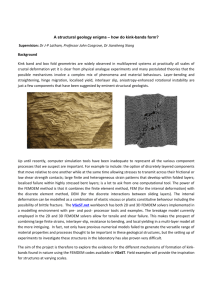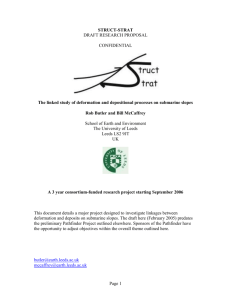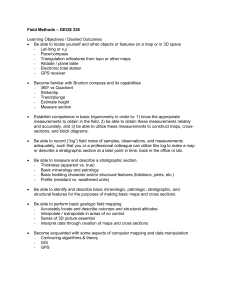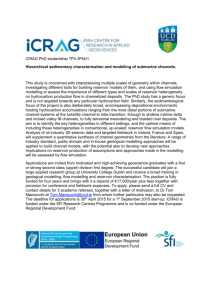Understanding the distribution of sand on continental slopes is
advertisement
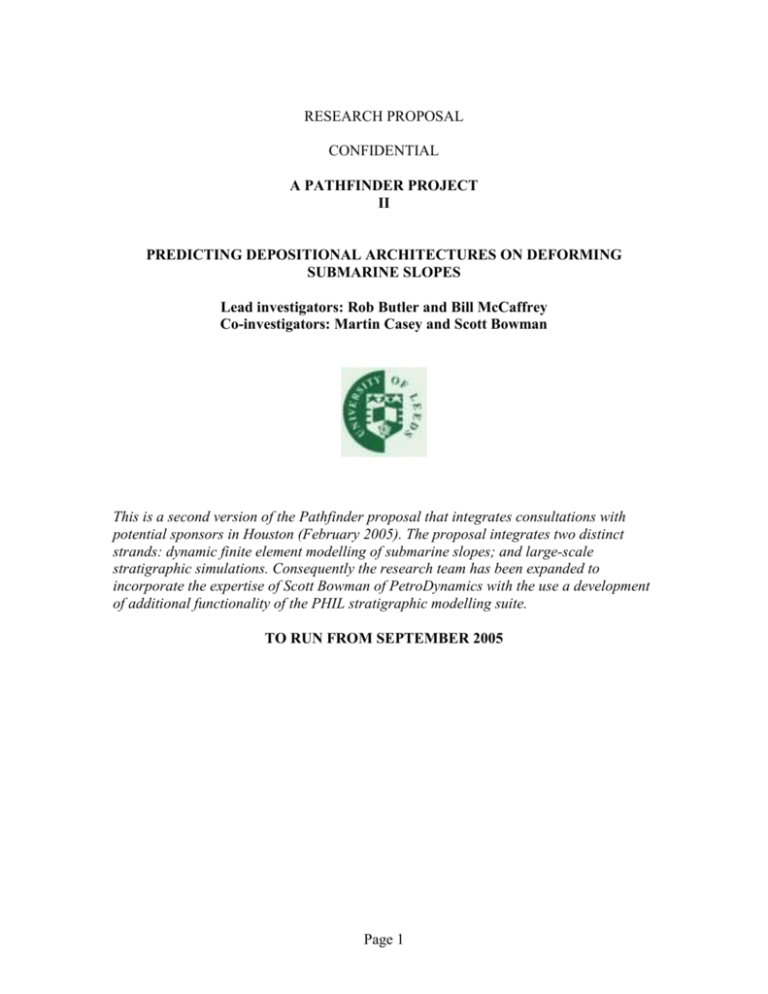
RESEARCH PROPOSAL CONFIDENTIAL A PATHFINDER PROJECT II PREDICTING DEPOSITIONAL ARCHITECTURES ON DEFORMING SUBMARINE SLOPES Lead investigators: Rob Butler and Bill McCaffrey Co-investigators: Martin Casey and Scott Bowman This is a second version of the Pathfinder proposal that integrates consultations with potential sponsors in Houston (February 2005). The proposal integrates two distinct strands: dynamic finite element modelling of submarine slopes; and large-scale stratigraphic simulations. Consequently the research team has been expanded to incorporate the expertise of Scott Bowman of PetroDynamics with the use a development of additional functionality of the PHIL stratigraphic modelling suite. TO RUN FROM SEPTEMBER 2005 Page 1 Preamble Submarine slope systems on continental margins contain substantial hydrocarbon resources that are a prime exploration target. However, drilling and production costs in the deep water are great. The Pathfinder justifications are: Better predictions on the depositional architectures of the sand-rich reservoir units on these slopes can reduce risk. Making these predictions requires a firm understanding of how the submarine slope has evolved and how sediments are distributed across these active slopes. Insights are needed of passive margin slope-dip and rugosity evolution that can be used to create synthetic 3D slopes for the periods of inferred reservoir deposition. Once developed, such understanding should permit probabilistic prediction of the distribution and characteristic architectures of sand bodies on deformed submarine slopes, calibrated for example by their distal depositional record at the toe of slope. Various approaches can be taken to model the distribution of sediment across slopes. Numerical approaches include diffusion-based models (e.g., PetroDynamics PHIL stratigraphic modelling), depth averaged numerical models (box models, finite element models) and non depth averaged models (finite element models, direct numerical simulation - DNS - models). Addition approaches entail application of the output from physical analogue (experimental) modelling and outcrop analogue studies. These approaches can be moderated though applying an understanding of the external controls on deep water clastics (work being pursued by TRG and others). To take this understanding into the subsurface, these researches need to be married with structural studies and predictions of slope evolution. Furthermore, as the deformation of submarine slopes through a combination of gravity sliding and gravity spreading is primarily driven by sediment load, structural and stratigraphic studies should be integrated into a coherent linked model. This is one of the aims of an over-arching, multi-client consortium project being organised to start in 2006 (outline attached). What is needed first is a pathfinder project that identifies the chief controls on the evolution of the system and to explore their interactions. The results of the pathfinder will inform and focus a large consortiumbased research program (Struct-Strat) starting in September 2006. Required research We believe the key platform for developing understanding of interacting deposition and deformation processes is a program of finite element forward modelling within which the effect of different parameters on system evolution can be explored and output tested against geologic observations. Deformation of poorly consolidated sediments in tectonically-driven thrust belts is informed by simple 2-D finite element models applied to critical wedge theory. In these models (e.g. Willett 1992), the tectonic push from the rear drives compression that is distributed through a sedimentary wedge as a function of the shape of that wedge (defined by its basal and surface slopes) together with the shear strength of the wedge sediments and of the basal layer. On submarine slopes built upon “passive” continental margins, deformation is caused by gravity spreading/sliding in response to spatial non-uniform loading by sedimentation. Consequently we propose to examine how deposition across a wedge of sediment drives deformation that in turn Page 2 modifies surface slope to influence subsequent deposition. The two key elements at this stage of the modelling are: Core 2-D finite element model of the system geometry, populated with rheological properties. We propose to use the Abaqus software suite, an industry-standard modelling platform that is supported at Leeds. A stratigraphic modelling package (e.g. the PetroDynamics PHIL software suite developed by Scott Bowman) – that builds synthetic depositional architectures including facies variations on submarine slopes. We also plan to use additional PHIL functionality to model the evolution of the basal slope through thermal and tectonic subsidence and isostatic sediment loading. Both of these are existing, ready-to-use technologies. In addition however, we propose to investigate the other critical controls on deformation that are implicit in critical wedge theory: As a starting point, the rheology of the sedimentary wedge can be pre-assigned and uniform – as in simple critical wedge models for tectonic thrust systems. Subsequent developments will examine the impact of depth-dependent strength profiles, approximating the rheological effects of compaction. Simple geotechnical data can be applied to depth vs compaction profiles from literature and involves elementary programming. Note that to account geometrically for compaction requires more complex methods, especially if it moves beyond 1D to account for interacting loads, and is best reserved for future developments of the finite element tool. The strength of the basal detachment zone of the gravitationally spreading wedge will be modelled using a plastic rheology. Existing models of submarine systems have adopted linear viscous rheology (e.g. Gemmer et al. 2004) that may be applicable to salt-founded systems but not to mud-founded ones. We believe that failure is sensitive to loading history and wish to investigate this effect, particularly in studying rates of response. Modelling plastic flow is routine in structural geology. Given sufficient funding the Pathfinder will contrasts different wedge and basal detachment rheologies. From the commentary above it is clear that the basic scientific foundation for the research is well-established. The novelty lies in linking these various strands within a single model. A consequence of the models is that element properties will need to be reassigned as they evolve, a tractable, necessary but computationally expensive process that represents the chief limit on the research. Each finite element model will generate a geologic history illustrated as a sequential developed array of cross-sections through the slope. These can be interrogated to establish: The evolution of the surface slope Sedimentation patterns on the slope These outputs can then be used for prediction of particular sedimentary architectures – depending on the sophistication of particular facies models for slopes. Additionally the internal attributes of the finite element models can be interrogated, including the distribution of deformation and of different rheological states. Both these and the stratigraphic predictions above can be tested against data from case studies, including those from appropriate assets. Page 3 An important component of any forward modelling approach is sensitivity analysis for the various parameters. Consequently we will run multiple scenarios for particular model configurations. The second approach is to use value ranges for the various input parameters that are derived from case studies. Finally, we propose to iterate our findings via tests against case studies. These could involve the use of proprietary data if appropriate or if there are issues specific to particular assets that sponsors wish to be addressed. Workflow In the pathfinder our two linked goals are to develop the finite element model to calculate deformations within sedimentary prisms in various rheological configurations and to integrate these approaches iteratively with output from the PHIL stratigraphic modelling package. Initial approaches will include assessing the state of stress within selected scaled stratigraphic simulations with various internal and basal rheologies. These static solutions will inform selection of boundary conditions for finite element modelling. Lastincrement geometries of sediment loads produced by the stratigraphic simulator will then be used to calculate vertical loads to drive deformation in the finite element model. The displacement field from that model will then be applied to the stratigraphic model. At early stages the models will deal with simple stratigraphic/deformation simulations to establish appropriate iterative workflows and to test model sensitivities to these workflows and to parameter choices. Later in the Pathfinder project, and subject to the number of participating sponsors, we will examine various case studies in more detail. The research team Rob Butler (RWHB: principal investigator): as a structural geologist with over 20 years experience in the large-scale evolution of thrust systems, Rob’s niche lies in developing multi-disciplinary approaches to understanding deformation and basin systems. Bill McCaffrey (WDM): as director of the Turbidites Research Group in Leeds, Bill brings 15 years experience on deep-water clastics to this project. Martin Casey (MC): with over 30 years experience in finite element modelling, Martin is ideally suited to lead on the finite element modelling in this project. Scott Bowman (SB): president of PetroDynamics and author of the PHIL software, with 20 years experience of stratigraphic modelling. There are three other key groupings at Leeds with which we liaise. The first is the Turbidites Research Group, currently pursuing fundamental research on the depositional processes of deep marine clastics. The Geophysics group in Leeds has further strength in geodynamic modelling (Houseman, Gemmer) upon which we can draw when necessary. The third group is the team of structural geologists within Rock Deformation Research, a university spin-off company that is a world leader in the provision of directed structural geology research and consultancy to the hydrocarbons and minerals industries. We have Page 4 close links with both groups, through a history of joint research projects and graduate student supervision. We value these links very highly as they provide a substantial intellectual resource. During the life-time of the project there will be a series of regular in-house seminars in which experience and expertise will be exchanged, subject to any confidentiality requirements of the various sponsor communities. The link with RDR may be viewed as particular useful to sponsors of our research as it provides opportunities for asset-specific follow-ups and consultancy on an ad hoc basis. Why a pathfinder project? Understanding the interacting processes of deposition and deformation across entire submarine slope systems requires doing some fundamental science. The impact on hydrocarbon exploration and development of the modelling outlined here is likely to be deep and wide-ranging, particularly in making better predictions of reservoir distribution. It will also provide a platform for predicting further parts of the geologic history including burial and pore-pressure evolution, This pathfinder project provides a mechanism to utilise the sponsor experience, catalyzed by collaboration with the Leeds group, to springboard a major programme of geoscience research that focuses on the evolution of submarine slopes. This will include having a major influence on the direction of the proposed main consortium project due to start in 2006. Pathfinder sponsors will benefit from early access to results and discounted subscription rates to the main Struct-Strat project. Project participation. Cost per sponsor: £26k (pounds sterling) ($50k), plus expenses for any sponsorspecific, Houston-based activities. The minimum number of sponsors for the pathfinder to run is 1. However, we will increase the deliverables commensurately with increased sponsor participation. Deliverables The project is designed to run through an initial phase of six months following which there will be a preliminary presentation of results to sponsors (invited meeting in Houston/London depending on participation, first-half of 2006). Key results will be housed on a password-protected website in the form of annotated Powerpoint presentations. Sponsors will also receive preprints of scientific manuscripts. The website will also provide links to key literature on the theme of the Pathfinder project. The meeting will conclude with a opportunity to brief the research team regarding sponsor expectations of the main Struct-Strat project starting in September 2006, springboarded by the Pathfinder. Page 5
